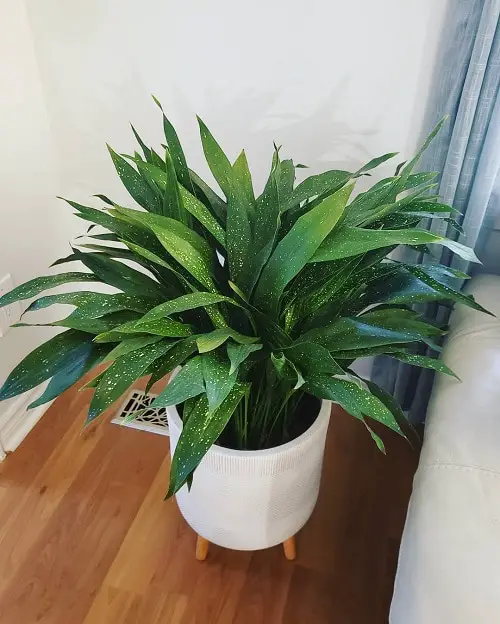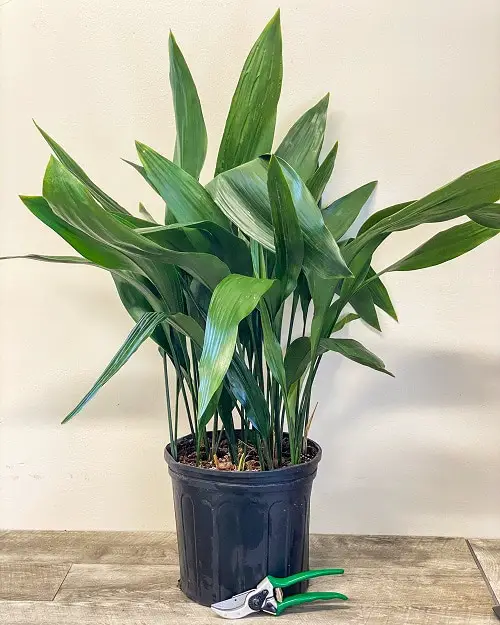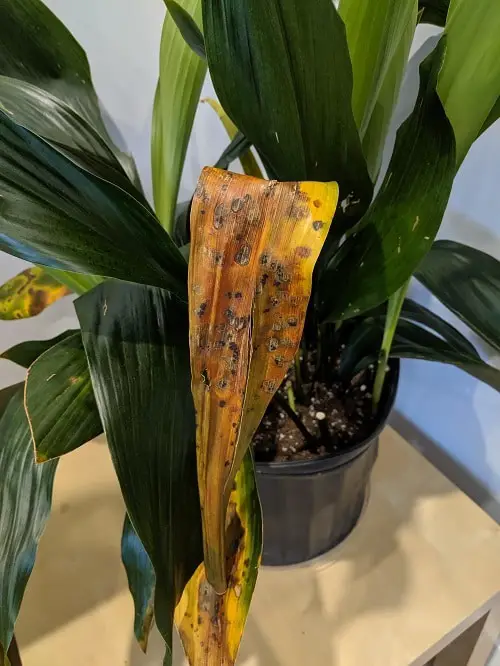An indestructible plant, the Aspidistra elatior brings beauty indoors with its glossy leaves. Here’s all the information you need on Cast Iron Plant Care!

The arching foliage of Aspidistra elatior with its deep green hue makes for a perfect houseplant. It also survives neglect and grows well in the shade. Let’s have a look at some great tips on Cast Iron Plant Care!
Check out some stunning cast iron pictures here
Propagating Cast Iron Plant

Cast-iron plants can be propagated through divisions. You can start a new plant by taking a rhizome piece that contains at least two leaves.
- Remove a mature cast iron from the pot – you can do this at the time of re-potting as well.
- Carefully separate the root clusters or rhizomes. Do not use a knife or trowel as it may damage the tender roots.
- Plant the rhizomes in a pot filled with fresh potting soil. Keep the soil moist and warm until new shoots grow.
- Be patient as the plant is a slow grower.
Best Varieties of Aspidistra Elatior

- Lennon’s Song: The foliage of this variety has light green or yellow vertical stripes.
- Okame or Variegata: This variety features white and green variegated leaves.
- Ashahi: It offers green leaves emerge white tips when the plant grows.
Requirements for Growing Cast Iron Plants

Location
Place the plant away from the direct sunlight as it can burn the foliage. While growing it as a houseplant, place it near a north-facing window. Outdoors, keep the plant in a shaded area, away from direct sunlight.
Soil
While growing indoors, use compost-base potting soil with a pH value between 5.5 to 6.5. Outdoors, you can grow the plant in clay or sandy soil.
Water
Cast Iron is a drought-tolerant plant, so you don’t have to water it much. Make sure not to overwater the plant as it can be fatal. Allow the plant to dry out between watering, and always check the topsoil with your fingers to see the soil is dry before you reach out for a can.
Temperature and Humidity
Cast-irons do best in the temperature between 45-85 F (7-30 C), but they will do just fine in an average indoor atmosphere. If you have a potted plant in your garden, don’t forget to bring it indoors before the first frost.
Cast Iron Plant Care

Fertilizer
Feed your cast-iron plant once every 4-5 weeks with an all-purpose liquid fertilizer in spring and summer. Remember that cast irons are slow-growers, and fertilization won’t boost up the speed of their growth.
Note: Apply fertilizer after watering the plant as it will save the roots from burning.
Re-potting
You can re-pot every other year as required, during springtime. Basically, rhizomatous plants like cast-iron can withstand less frequent repotting. Check when the plant has outgrown the pot and roots are spilling over the edges.
Tip: Go for a container that’s a couple of inches wider than the plant’s rootball.
Pruning
You can remove dry or dead leaves all-year-round, but do major pruning in the spring and summer months. Use clean, sharp shears and snip any excessive growth at the base of the stem.
Cleaning
The large leaves accumulate dust and dirt over a period of time. Take a soft cotton cloth and wipe the leaves gently. Follow this cleaning regimen once a month to prevent pests and help the foliage to soak more sun.
Pest and Diseases
Cast-iron plants can be affected by leaf blotch, which appears as black or brown spots that continue to spread before the leaves fall off. In such cases, remove the infected leaves from the plant immediately.
The plant can be attacked by spider mites, mealybugs, and scales. Use neem oil solution or a strong jet of water to get rid of them. Also, separate healthy plants from the affected ones.
Some Important Points to Consider

1. Leaves Turning Yellow or Brown
In such cases, the cause is waterlogged soil since cast irons like to stay evenly moist and do not prefer soggy soil. Another reason behind this issue is plants receiving too much light. Avoid direct light and do not overwater the plant.
2. Brown Leaf Tips
If you notice brown tips, then the reason is underwatering. Though cast-iron plants are very patient, they will show distress if ignored for long periods of time.
The other cause can be mineral accumulation, as in some areas, tap water is high in minerals. Overcome this problem by using well or spring water.


